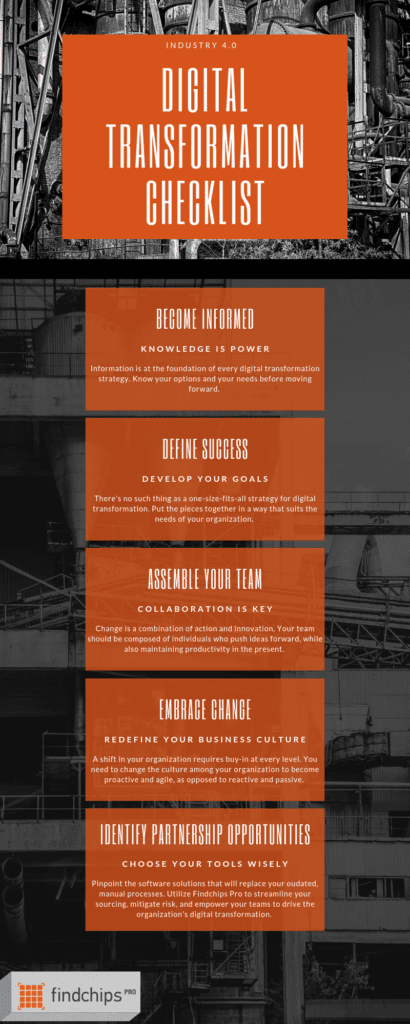- Solutions
ENTERPRISE SOLUTIONS
Infuse new product development with real-time intelligenceEnable the continuous optimization of direct materials sourcingOptimize quote responses to increase margins.DIGITAL CUSTOMER ENGAGEMENT
Drive your procurement strategy with predictive commodity forecasts.Gain visibility into design and sourcing activity on a global scale.Reach a worldwide network of electronics industry professionals.SOLUTIONS FOR
Smarter decisions start with a better BOMRethink your approach to strategic sourcingExecute powerful strategies faster than ever - Industries

Compare your last six months of component costs to market and contracted pricing.

- Platform
- Why Supplyframe
- Resources
The fourth industrial revolution is in full swing. At this point, Industry 4.0 is a well-accepted term in industrial automation, but it’s about more than new technology. This revolution bridges the gap between data and production.
To truly step into this new era of manufacturing, organizations must adopt the principles of a digital transformation and revolutionize not only their products and solutions, but also their culture. Join us as we lay out a checklist and roadmap to help both you and your clients achieve your goals now, and into the future.
5 Steps to Embrace Industry 4.0 and Digital Transformation
Automation in manufacturing is about more than just designing robotics that can perform tasks throughout a factory. While this is certainly part of the equation, new technology also empowers us to automate the gathering and application of data.
This leads to increased efficiency, smarter decision-making, and growth that goes straight to your bottom line. If you haven’t fully embraced the digital future, it’s time to start before you’re left behind.
This kind of lasting change doesn’t come from small changes, however. It requires a comprehensive transformation. Here are five steps that will help you establish both a checklist and a roadmap to your success:
1) Become Informed
Information is the foundation of any digital transformation strategy. You need to have a bird’s eye view of the industry, the technology, and the tools at your disposal.
You also need to have the same level of perspective and visibility into your own organization. These two pieces must come together to inform your overall strategy.
Start by looking at the technology available to you and your organization. Here are a few examples:
- Autonomous robotics
- Edge computing
- Machine learning
- Predictive analytics
- Industrial IoT
Understanding the current and future applications of these technologies will offer countless potential applications. Say, for example, you want to better catalog and utilize data from your factory floor. This is a great use case for edge computing.
A keen understanding of the technology is the just the beginning. Next, you need to establish the current status of your organization by asking a few key questions:
What steps have we taken to embrace digital solutions?
How do we compare to the capabilities of our competitors?
What elements of the business could benefit from new technology and digital solutions?
With an understanding of your current capabilities, and the options available to you, it’s time to take the next step.
2) Define Success
The first thing you’ll need to accept is the fact that there is no such thing as a one-size-fits-all strategy for digital transformation. Instead, it’s about putting the pieces together in a way that suits the needs of your organization.
It starts with a roadmap. Map out of the objectives that you want to reach. This includes embracing new technologies, breaking down silos, adopting software solutions, and any other steps you need to take to fully transform your business practices.
As you’re building these goals, you should also lay the groundwork for a flexible IT environment that can quickly adopt new initiatives. An Office of the CIO would be a key player here in helping you pinpoint new technology that offers ROI improvements without too much disruption.
Ultimately, the goal here is to build out the roadmap and communicate it to the key players within your various teams. By keeping your IT department in the loop, you can ensure smooth transitions and accountability as you take the next steps.

3) Assemble your team
Change involves a combination of action and innovation. Your team should be composed of a balanced skill set that pushes new ideas forward, while keeping progress and productivity in mind.
Collaboration is key here. Your Office of the CIO will need to collaborate with the greater IT team, while also keeping engineering, procurement, and other departments in the loop about goals and upcoming changes.
As part of this system that includes checks and balances, you will need team members who monitor progress, hold relevant team members accountable, and consider the profitability of every decision.
To achieve these goals, you may need to hire new personnel, but the most crucial step will be breaking down traditional silos. By encouraging collaboration and communication across departments, you will open the floodgates for information and ideas to flow freely across the organization.
This crucial step, combined with a strong team of innovators and problem solvers, will propel your digital transformation forward.
4) Embrace Change
A shift like this is substantial and permanent. Therefore, the organization’s culture needs to change alongside everything else. In many cases, an aversion to change or a culture unfit to drive the transformation can be the largest obstacle.
Start with achieving buy-in from the major players in the organization, and then incorporate all the other individuals and teams. Focus on being proactive instead of reactive. Test constantly, break down silos, and encourage cross-team collaboration.
Keep in mind in both your personal and professional messaging, that this is a permanent change, and it’s always ongoing. The shift in culture from the old to the new is a critical part of this checklist.
5) Identify Partnership Opportunities
Once you have a roadmap and a team structure in mind, the next step is to look for specific technologies or software solutions. These partnerships will become critical to your success in the long-term. Start by updating your tools, specifically your sourcing, quoting, and procurement solutions.
Outdated methods and manual processes will drag down any progress you make in other areas of the business. As you explore your options, be sure to take a look at Findchips Pro, which streamlines your sourcing and procurement by connecting your BOM to a constantly updated database.



